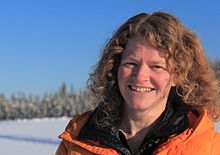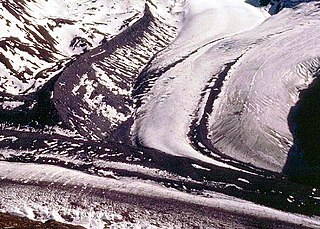
Glaciology is the scientific study of glaciers, or more generally ice and natural phenomena that involve ice.

The University of Alaska Fairbanks is a public land-grant research university in College, Alaska, a suburb of Fairbanks. It is the flagship campus of the University of Alaska system. UAF was established in 1917 and opened for classes in 1922. Originally named the Alaska Agricultural College and School of Mines, it became the University of Alaska in 1935. Fairbanks-based programs became the University of Alaska Fairbanks in 1975.

Thwaites Glacier, nicknamed the Doomsday Glacier, is an unusually broad and vast Antarctic glacier flowing into Pine Island Bay, part of the Amundsen Sea, east of Mount Murphy, on the Walgreen Coast of Marie Byrd Land. Its surface speeds exceed 2 kilometres per year near its grounding line. Its fastest-flowing grounded ice is centered between 50 and 100 kilometres east of Mount Murphy. In 1967, the Advisory Committee on Antarctic Names named the glacier after Fredrik T. Thwaites (1883–1961), a glacial geologist, geomorphologist and professor emeritus at the University of Wisconsin–Madison.
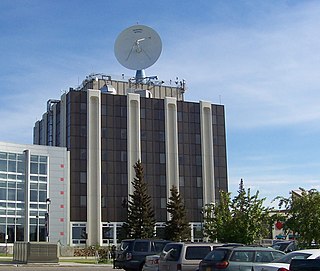
The Geophysical Institute of the University of Alaska Fairbanks conducts research into space physics and aeronomy; atmospheric sciences; snow, ice, and permafrost; seismology; volcanology; and tectonics and sedimentation. It was founded in 1946 by an act of the United States Congress.

The Whitney Glacier is a glacier situated on Mount Shasta, in the U.S. state of California. The Whitney Glacier is the longest glacier and the only valley glacier in California. In area and volume, it ranks second in the state behind the nearby Hotlum Glacier. In 1986, the glacier was measured to be 126 ft (38 m) deep and over three km in length. The glacier starts on Mount Shasta's Misery Hill at 13,700 ft (4,200 m) and flows northwestward down to the saddle between Mount Shasta and Shastina, where uneven ground causes a major icefall at 11,800 ft (3,600 m). It then flows down the valley between the two peaks, reaching its terminus at 9,500 to 9,800 ft.

Eric J. Rignot is a chancellor professor of Earth system science at the University of California, Irvine, and senior research scientist for the Radar Science and Engineering Section at NASA's Jet Propulsion Laboratory.
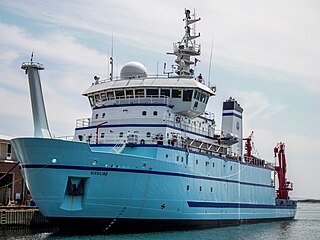
RVSikuliaq is an American research vessel owned by the National Science Foundation and operated by the University of Alaska Fairbanks College of Fisheries and Ocean Sciences. Built in 2014 by Marinette Marine Corporation in Marinette, Wisconsin, the $200 million vessel replaced the 1966-built research vessel Alpha Helix that was retired in 2007. Sikuliaq, named after the Iñupiaq word for "young sea ice" and pronounced "see-KOO-lee-auk", will be homeported in Seward, Alaska.
Ellen Mosley-Thompson is a glaciologist and climatologist. She is a Distinguished University Professor at The Ohio State University and director of their Byrd Polar and Climate Research Center. She is known as a pioneer in the use of ice cores from the Polar Regions for paleoclimatic research and is an influential figure in climate science. She is an elected fellow of the American Association for the Advancement of Science, the American Geophysical Union and an elected member of the National Academy of Sciences.
Helen Amanda Fricker is a glaciologist and professor at Scripps Institution of Oceanography at the University of California, San Diego where she is a director of the Scripps Polar Center. She won the 2010 Martha T. Muse Prize for Science and Policy in Antarctica.

Julie Michelle Palais is an American polar glaciologist who has made significant contributions to climate change research studying volcanic fallout in ice cores from both Greenland and Antarctica. For many years, starting in 1990, she played a pivotal role working at the National Science Foundation (NSF) as Program Director of the Antarctic Glaciology Program in the Division of Polar Programs, including many trips to both North and South Polar regions. Both the Palais Glacier and Palais Bluff in Antarctica were named in her honor and she has received many further recognitions for her distinguished career.
Jerilynn "M" Jackson is an American geographer, glaciologist, and National Geographic Society Explorer. She is the author of the popular science books The Secret Lives of Glaciers and While Glaciers Slept: Being Human in a Time of Climate Change.M Jackson is a 2018 TED Fellow.

Konstantin Grigorievich Makarevich was a Soviet and Kazakhstani glaciologist. He made a significant scientific contribution to the development and popularization of glaciology. He headed the Soviet glaciological expedition on the Tuyuksu glacier from 1956 to 1992, and was the founder of the Tuyuksu glaciological station. For more than 20 years, he was as an official representative of the Soviet Union in the World Glacier Monitoring Service (WGMS). He authored more than 200 scientific articles, monographs, regional and autobiographical books, and essays. Two glaciers and two passes in the Trans-Ili and Dzhungarian Alatau are named after him. He was a veteran of the World War II, an order-bearer.
Michele Koppes is an associate professor at the University of British Columbia who uses glaciology and geomorphology to study climate and changing landscapes.

Amelia E. Shevenell is an American marine geologist who specializes in high-latitude paleoclimatology and paleoceanography. She is currently an Associate Professor in the College of Marine Science at the University of South Florida. She has made notable contributions to understanding the history of the Antarctic ice sheets and published in high-impact journals and, as a result, was awarded full membership of Sigma Xi. She has a long record of participation in international ocean drilling programs and has served in leadership positions of these organizations. Shevenell is the elected Geological Oceanography Council Member for The Oceanography Society (2019-2021).
Kirsteen Jane Tinto is a glaciologist known for her research on the behavior and subglacial geology of the Greenland and Antarctic ice sheets.

Guðfinna 'Tollý' Aðalgeirsdóttir is professor in Geophysics at the Faculty of Earth Sciences, University of Iceland.
Gwenn Elizabeth Flowers is a Canadian/American glaciologist. She is a professor in the Department of Earth Sciences at Simon Fraser University (SFU) and an adjunct professor at the University of Iceland. As a Canada Research Chair from 2005–2014, she established a research program dedicated to the geophysical study of glaciers.
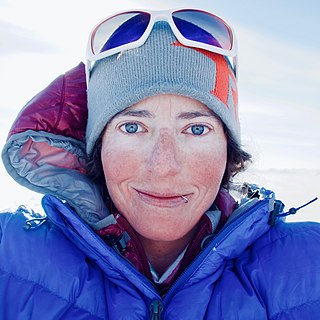
Alison Criscitiello is an ice core scientist, National Geographic Explorer, Fellow of the Royal Canadian Geographical Society, and Director of the Canadian Ice Core Lab at the University of Alberta. In addition to her academic work, she is a co-founder of Girls on Ice Canada and an avid adventurer and mountain climber. She led the first all-women ascent of Lingsarmo and has received numerous American Alpine Club grants for her pioneering expeditions.

Jérôme Chappellaz is a French glaciologist, geochemist and paleoclimatologist who is director of the French Polar Institute. A senior researcher at France's National Center for Scientific Research (CNRS), he is a co-founder and chairman of the Ice Memory Foundation.
Sarah Das is an American glaciologist and climate scientist. She works at the Woods Hole Oceanographic Institute in Woods Hole, Massachusetts.
